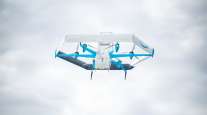Federal Proposal to Regulate Drones Could Delay Package-Delivery Potential

This story appears in the March 2 print edition of Transport Topics.
Proposed federal rules on unmanned aerial vehicles are likely to delay the ability of companies to offer delivery services via drones, industry officials said.
The Federal Aviation Administration’s proposed rules, published in the Feb. 23 Federal Register, would limit drones and their cargo to 55 pounds, require visual line-of-sight by operators, set a maximum air speed of 100 mph and height of 500 feet, and would not allow drones to fly over people not directly involved in their operation.
“Technology is advancing at an unprecedented pace, and this milestone allows federal regulations and the use of our national airspace to evolve to safely accommodate innovation,” Transportation Secretary Anthony Foxx said in a statement.
The rules are “a step in the right direction that we’ve been waiting on since 2012, but there are still some hurdles” to widespread use of drones, said Chad Swan, founder of UAV Consulting Group in Pensacola, Florida.
“Package delivery by drones in the United States is still quite a ways out,” he told Transport Topics. If drones are delivering packages in a city, “that puts you right above people, where the FAA says you can’t fly.”
Amazon.com, which wants to deliver packages via drone, last year asked FAA to expand testing outside of its research labs. Last week, the e-commerce giant said the proposal would delay plans for its Prime Air drone delivery service.
“The FAA’s proposed rules for small [drones] could take one or two years to be adopted and, based on the proposal, even then those rules wouldn’t allow Prime Air to operate in the United States,” said Paul Misener, vice president of Amazon.com’s global public policy.
“The FAA needs to begin and expeditiously complete the formal process to address the needs of our business, and ultimately our customers,” Misener said. “We are committed to realizing our vision for Prime Air and are prepared to deploy where we have the regulatory support we need.”
FAA is taking comments on the rule for 60 days, through April 24, via www.regulations.gov.
The rules could take several years to be implemented, a Government Accountability Office official told Congress in December.
A trade group that represents drone development interests said the proposal was a good first step toward greater use of UAV technology.
“This proposed rule is a critical milestone in the [unmanned aircraft system] integration process and one that is long overdue,” said Brian Wynne, president of the Association for Unmanned Vehicle Systems International.
“We believe it’s important that the final rule enables the many civil and commercial uses for UAS technology in a safe and responsible manner and without being unnecessarily restrictive,” he said.
A study by the group said the industry is projected to create more than 100,000 jobs and $82 billion in economic impacts in the first decade after commercialization of drone systems.
One company that makes electric trucks and wants to market drone systems as part of deliveries said it is testing a system that would operate drones out of delivery vehicles.
Cincinnati-based Amp Holdings, which makes Workhorse electric delivery trucks, said its “HorseFly” drone would deliver small packages from trucks while drivers run their routes.
CEO Steve Burns described the system as “very James Bond-ish — it’s integrated into the truck and really brings dramatic efficiencies into the delivery process.”
Burns said Amp has had “great interest” from delivery companies about the HorseFly system but declined to identify them.
“We’re thrilled with the rules,” he said. “A lot of people have waited for years for these guidelines . . . [and] this is a sea change the way goods are transported. This isn’t for tomorrow, but if you want to be ready when the FAA [releases a final rule], you have to start preparing now.”
The HorseFly system is not designed to generally go more than a mile from a delivery truck, which Burns described as being “like a rolling warehouse.”
Amp supplies trucks to delivery companies, including UPS Inc., and uniform and food-delivery businesses.
Like Amazon.com, the company has asked FAA that it be allowed to test its system beyond its controlled, indoor testing grounds.




